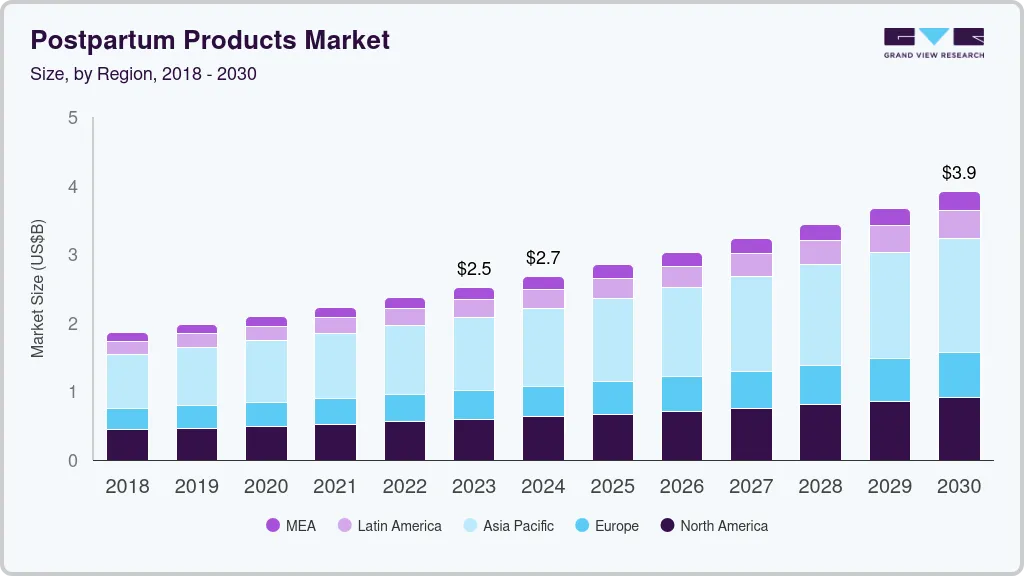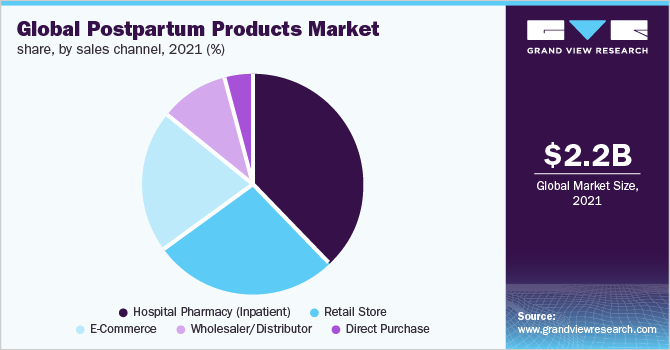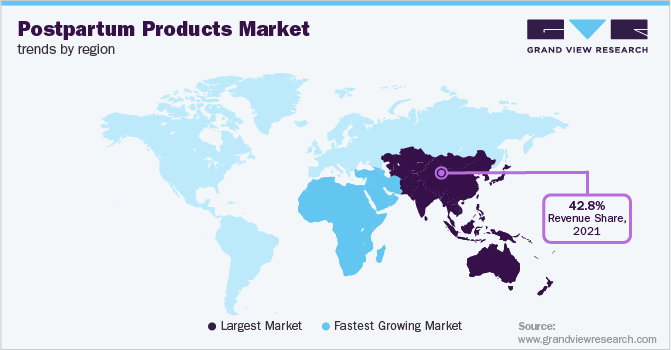- Home
- »
- Medical Devices
- »
-
Postpartum Products Market Size, Share & Growth Report, 2030GVR Report cover
![Postpartum Products Market Size, Share & Trends Report]()
Postpartum Products Market (2024 - 2030) Size, Share & Trends Analysis Report By Product (Breastfeeding Accessories, Perineal Cooling Pads, Others), By Sales Channel (Hospital Pharmacy, Retail Store, E-Commerce), By Region, And Segment Forecasts
- Report ID: GVR-4-68038-351-5
- Number of Report Pages: 110
- Format: PDF
- Historical Range: 2018 - 2022
- Forecast Period: 2022 - 2030
- Industry: Healthcare
- Report Summary
- Table of Contents
- Interactive Charts
- Methodology
- Download FREE Sample
-
Download Sample Report
Postpartum Products Market Summary
The global postpartum products market size was estimated at USD 2.51 billion in 2023 and is projected to reach USD 3.90 billion by 2030, growing at a CAGR of 6.5% from 2024 to 2030. The worldwide surge in women’s employment rate and growing consumer awareness about postpartum products coupled with development in healthcare infrastructure in emerging economies is expected to positively impact the postpartum products market growth during the forecast period.
Key Market Trends & Insights
- In terms of region, Asia Pacific dominated the overall postpartum product market with a share of 42.79% in 2021.
- Middle East & Africa is expected to expand at the fastest CAGR of 6.8% from 2022 to 2030.
- By product, breastfeeding accessories segment dominated the market with a revenue share of 88.01% in 2021.
- By sales channel, E-commerce segment is expected to develop at the fastest CAGR of 7.3%, during the forecast period.
Market Size & Forecast
- 2023 Market Size: USD 2.51 Billion
- 2030 Projected Market Size: USD 3.90 Billion
- CAGR (2024-2030): 6.5%
- Asia Pacific: Largest market in 2021
However, owing to the current outbreak of COVID-19, the market is expected to witness slow growth for a short period. Demand for these products has decreased as many companies are facing short-term operational issues owing to supply chain constraints (restrictions at international borders).

The offline sales channel including pharmacies, hypermarkets, specialty stores, and departmental stores which majorly contribute to revenue generation of postpartum products, are shut worldwide. To deal with this situation majority of the brands are trying to engage their consumers online. However, the postpartum products market does not have any direct impact due to COVID-19, hence the demand for these products is likely to gain momentum as the effect of the pandemic subsides with time.
An increase in women’s employment rate is expected to be a high-impact rendering driver of the postpartum products market. Increased involvement of women in the workforce is making them more self-sustainable and financially strong, leading to the adoption of quality healthcare products for them and their babies, which, in turn, is fueling the postpartum products market growth. As per the International Labor Office (ILO), there has been visual progress in terms of employment opportunities and gender equality over the past 20 years.
ILO initiated the 2030 UN agenda, which aims to empower all women and girls, for achieving productive employment, and likely to have equal pay without discrimination to achieve gender equality. Thus, increasing global women employment rates and government initiatives in support of employed mothers are expected to drive demand for postpartum products during the forecast period.
In addition, lactating mothers also focus on their skincare and physical appearance post-pregnancy, which is encouraging adoption of the postpartum care products. Various other issues associated with post-pregnancy include skin pigmentation, stretch marks, varicose veins, or adult acnes. As a result, the demand for postpartum products such as stressed leg creams, nipple protection creams, lotions & gels, and body restructuring products is also increasing, thus, contributing to the postpartum products market growth in the forecast period.
Moreover, growing consumer awareness to get body shape and functions back to normal and supportive initiatives being undertaken by governments and companies for breastfeeding across the world are the factors anticipated to propel the demand for postpartum products throughout the forecast period.
For instance, in September 2017, Belly Bandit- a U.S.-based company, a pioneer in manufacturing products for pre and post-pregnancy, launched its health insurance reimbursement package to offer pregnant women and new moms medically essential pregnancy support products and postpartum belly wraps. Under this program, the company offers its compression wraps, 2-in-1 Bandit, Upsie Belly, and C-section & Recovery Undies for insurance coverage and flexible spending accounts (FSA) reimbursement.
Such initiatives are expected to increase the usage of these products. As a result, the purchase of postpartum products becomes easier for the end users, thereby contributing to the postpartum products market growth during the forecast period. In addition, extensive marketing campaigns by the key market players to influence customers through social media are the factors also boosting the adoption of postpartum products. Therefore, these players are heavily investing in advertising campaigns to increase their product penetration and market positioning.
The U.S. dominated the postpartum products market with the largest revenue share in 2021 owing to the high spending on personal care products and the availability of better reimbursement policies regarding maternity care in the region. For instance, insurance companies in the U.S. have to cover the cost of equipment and services that promote breastfeeding, such as breastfeeding accessories, 6-week postpartum care, and lactation counseling.
In addition, various market players, such as Medela LLC, Laura & Co., Newell Brands, Ameda, &universities, including Washington University and Fudan University, are raising awareness among women about breastfeeding and its benefits by arranging campaigns and providing informative magazines. This is expected to boost demand for breastfeeding accessories such as breast pads, breast shells, breast milk storage & feeding bottles, and others in the forecast period.
Furthermore, due to the higher demand for breast milk storage and nipple care products, the number of milk banks is rising. Milk banks are beneficial for mothers and is also a progressive initiative. If the mother is infected, there occurs a risk of disease transmission, and the mother is unable to lactate. Thus, an increasing number of milk banks in the U.S. is anticipated to boost demand for the postpartum products during the forecast period. For instance, according to Atlantic in 2017, the Human Milk Banking Association of North America (HMBANA) accredited double the number of milk banks that operated 5 years ago. Thus, the demand for postpartum products in the U.S. is expected to be high.
Product Insights
Based on product, the postpartum products market is segmented into breastfeeding accessories, perineal cooling pads, and others (heavy flow panty pads, water squirt bottle, nursing pillows). Breastfeeding accessories segment dominated the overall market in terms of revenue as of 2021 with a share of 88.01%. The factors driving the growth of the segment include surge in women employment rates, decreasing infant mortality rate, growing awareness about the availability of breastfeeding accessories, improving healthcare infrastructure in emerging economies, and increasing number of milk banks.
Moreover, some countries have supportive reimbursement policies which are anticipated to increase the sales of the breastfeeding accessories in those regions. Breastfeeding accessories covers a wide range of the products used for breastfeeding a newborn and products that makes the whole process convenient for the lactating mothers.
It is further sub-segmented into breast pads, nipple care products, breast shells, breast milk preparation & cleaning products, breast milk storage & feeding, and other accessories. Among these, breast milk storage & feeding segment is expected to dominate the breastfeeding accessories market in terms of revenue as of 2021.
Whereas perineal cooling pads segment is expected to grow at the highest CAGR of 4.5% during the forecast period owing to the increasing application of these cooling pads for relieving perineal pain which results in increased postpartum comfort in all women. Postpartum perineal pain adversely affected daily activities of the mothers such as sitting, lying down, walking, baby care, and breastfeeding.
Perineal cold pack helps to ease the pain and swelling after childbirth and pain caused by hemorrhoids. Thus, increasing burden of the post pregnancy problems, rising disposable incomes, especially in developing countries, increasing awareness regarding the postpartum care products among women are the major factors driving growth of the segment during the forecast period.
Sales Channel Insights
Based on sales channel, the postpartum product market is segmented into hospital pharmacy (inpatient), retail store, e-commerce, wholesaler/distributor, and direct purchase. Among all distribution channels, hospital pharmacy held the largest share of the market in terms of revenue as of 2021 with a share of 38.40%. The increasing pregnancy rate globally and the rise in demand for postpartum products among new mothers are the factors anticipated to boost the growth of the segment.
Moreover, hospital pharmacies are trusted by the consumers for baby and mother products due to the safety concerns. Hence, parents' trust on doctors and specialist is high and this factor drives the growth of the hospital pharmacy segment. In addition, the rising number of hospitals in both developed, as well as developing countries, has led to high growth of this segment during the forecast period.

E-commerce segment is expected to develop at the highest CAGR of 7.3%, during the forecast period. Rising online and e-commerce accessibility of the postpartum products is likely to aid in market expansion, as it allows the end users to compare and select suitable products based on their type, brand, price, and point of sales. For instance, Amazon, Belly Bandit, Wal-Mart, Motherhood maternity, The Moms Co. are some of the leading online providers that supply to end users.
In addition, major companies such as, Koninklijke Philips N.V., Medela LLC, Newell Brands, and Ameda have started offering a broad range of postpartum products through online channels. The sales strategies such as buy-one get-one offers, discounts, and complimentary products attract more consumers. This is likely to drive sales of the postpartum products through this channel, as they are always on high demand among the consumers.
Regional Insights
Asia Pacific dominated the overall postpartum product market with a share of 42.79% in 2021. The large market share of the region can be attributed to by various awareness campaigns leading to increasing awareness level and keen focus of the key market players on tapping the potential offered by this region. For instance, in May 2018, Medela Asia Pacific Breastfeeding and Lactation Symposium aimed at enhancing knowledge & awareness, and clinical practice through various presentations on latest research in human milk and breastfeeding. Increasing female working population coupled with presence of large population base in the region is further expected to drive growth of the market. Besides, the region has been witnessing a paradigm shift in customer buying behavior with increasing disposable income. Thus, owing to these factors Asia Pacific will remain an essential regional market for the foreseeable future.
Middle East & Africa is expected to expand at a highest compound annual growth rate (CAGR) of 6. 8% from 2022 to 2030. The presence of large population in the region and increasing government collaboration with various global-level organizations for the financing its healthcare development programs is expected to drive the growth of market. Middle Eastern countries such as Saudi Arabia, Qatar, United Arab Emirates (UAE), Kuwait, and Oman are prospering economies.

This region is technologically developed, but the penetration of postpartum products is less, due to the cultural barriers. Thus, MEA is a largely untapped market for the postpartum products. As a result, the companies can tap the market and increase the sales of postpartum products by their marketing and promotion efforts. This is expected to drive the market growth during the forecast period.
Key Companies & Market Share Insights
The companies are adopting several strategies including new product launch and promotion of offline and online sales in order to attract more customers in the postpartum products market. Moreover, these companies are also focusing on geographic expansion to maximize their revenue in the developing economies. For instance, Pigeon Corporation has expanded its geographic footprint by building an R&D facility in the Free Trade Zone in Izmir, Turkey. The company also expanded its presence in regions such as Malaysia, South Korea, Brazil, Belgium, India, and China.
Furthermore, several companies engaged in product launches to strengthen their market position. This strategy enables companies to increase their capabilities, expand their product portfolios, and improve its competencies. For instance, in August 2021, Medela AG introduced a new silicone breast milk collector in North America. This product was designed to help lactating mothers minimize milk loss and increase the company’s market share in North America.
Strategies such as marketing and promotions are widely used by the companies in the market to increase awareness about the benefits of breastfeeding, educate, encourage and support breastfeeding mothers, and also to increase the availability and outreach of their product offerings. For instance, Medela LLC frequently distributes educational and informative content to support breastfeeding mothers and their family, and also initiated distribution of the information on breastfeeding through Amazon Alexa. This is supporting the postpartum market growth during the forecast period.Some of the prominent players in global Postpartum Products Market include:
-
Koninklijke Philips N.V.
-
Medela LLC
-
Newell Brands
-
Ameda
-
NUBY
-
May born Group Limited
-
Edge well Personal Care
-
Handi-craft Company (Dr. Brown’s)
-
Artsana S.P.A
-
Medline
Postpartum Products Market Report Scope
Report Attribute
Details
Market size value in 2024
USD 2.67 billion
Revenue forecast in 2030
USD 3.90 billion
Growth Rate
CAGR of 6.5% from 2024 to 2030
Base year for estimation
2023
Historical data
2018 - 2022
Forecast period
2024 - 2030
Quantitative units
Revenue in USD million and CAGR from 2024 to 2030
Report coverage
Revenue forecast, company ranking, competitive landscape, growth factors, trends
Segments covered
Product, sales channel, region
Regional scope
North America, Europe, Asia Pacific, Latin America, MEA
Country scope
U.S., Canada, U.K., Germany, France, Italy, Spain, Japan, China, India, Australia, South Korea, Brazil, Mexico, Colombia, Argentina, South Africa, Saudi Arabia, UAE
Key companies profiled
Koninklijke Philips N.V., Medela LLC, Newell Brands, AMEDA, NUBY, May born Group Limited, Edge well Personal Care, Handi-Craft Company (Dr. Brown’s), Artsana S.P.A, Medline.
Customization scope
Free report customization (equivalent up to 8 analyst’s working days) with purchase. Addition or alteration to country, regional & segment scope
Pricing and purchase options
Avail customized purchase options to meet your exact research needs. Explore purchase options
Global Postpartum Products Market Segmentation
This report forecasts revenue growth at the global, regional & country levels and provides an analysis on the latest trends in each of the sub-segments from 2018 to 2030. For this study, Grand View Research has segmented the global postpartum products market report based on the product, sales channel, and region:

-
Product Outlook (Revenue, USD Million, 2018 - 2030)
-
Breastfeeding Accessories
-
Breast Pads
-
Nipple Care Products
-
Breast Shells
-
Breast milk Preparation & Cleaning Products
-
Breast milk Storage & Feeding
-
Other Accessories
-
-
Perineal Cooling Pads
-
Others
-
-
Sales Channel Outlook (Revenue, USD Million, 2018 - 2030)
-
Hospital Pharmacy (Inpatient)
-
Retail Store
-
E-Commerce
-
Wholesaler/Distributor
-
Direct Purchase
-
-
Regional Outlook (Revenue, USD Million, 2018 - 2030)
-
North America
-
U.S.
-
Canada
-
-
Europe
-
Germany
-
U.K.
-
France
-
Italy
-
Spain
-
-
Asia Pacific
-
Japan
-
China
-
India
-
Australia
-
South Korea
-
-
Latin America
-
Brazil
-
Mexico
-
Argentina
-
Colombia
-
-
Middle East and Africa (MEA)
-
South Africa
-
Saudi Arabia
-
UAE
-
-
Frequently Asked Questions About This Report
b. The global postpartum products market size was estimated at USD 2, 223.76 million in 2021 and is expected to reach USD 2.36 billion in 2022.
b. The global postpartum products market is expected to grow at a compound annual growth rate of 6.4% from 2022 to 2030 to reach USD 3.90 billion by 2030.
b. Asia pacific dominated the global postpartum products market with a share of 42.79% in 2021. This is attributable to various awareness campaigns leading to increasing awareness levels and a keen focus of key market players on tapping the potential offered by this region.
b. Some of the key players operating in the global postpartum products market include Koninklijke Philips N.V., Medela LLC, Newell Brands, AMEDA, NUBY, Mayborn Group Limited, Edgewell Personal Care, Handi-Craft Company (Dr. Brown’s), Artsana S.P.A, and Medline. Pigeon Corporation.
b. Key factors that are driving the postpartum products market growth include a Worldwide surge in women’s employment rate, growing consumer awareness about postpartum products coupled with development in healthcare infrastructure in emerging economies.
Share this report with your colleague or friend.
Need a Tailored Report?
Customize this report to your needs — add regions, segments, or data points, with 20% free customization.

ISO 9001:2015 & 27001:2022 Certified
We are GDPR and CCPA compliant! Your transaction & personal information is safe and secure. For more details, please read our privacy policy.
Trusted market insights - try a free sample
See how our reports are structured and why industry leaders rely on Grand View Research. Get a free sample or ask us to tailor this report to your needs.










